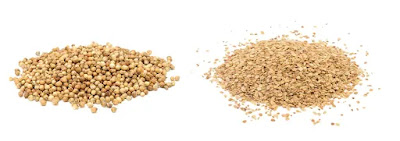One of the best aspects of indoor hydroponic units is how very 'plug and play' they can be. Even people with a notoriously 'brown thumb' can have a lovely garden with very little effort. While you can get very precise and exacting, tweaking things to truly maximize longevity and harvest, it's really not necessary to get plenty of satisfaction and taste.
However, there are a few commonly grown seeds that benefit – if not outright require – a little special attention to get them growing.
No Wet Feet!
The most common seeds in need of a little special attention, are a small group of herbs that don't like very wet conditions. This group includes Rosemary, Sage, Oregano, and Thyme. If you simply leave them to grow as normal, they often won't germinate at all, or die shortly thereafter, before they even get big enough to show over the label. Luckily, there's a very simple trick that gives near-perfect results for these otherwise notoriously difficult herbs.
Start your seed pods as normal, and give them a day or two to give the seeds a good soaking, to trigger germination. Remove the pod carefully, and gently lift up the sponge inside so it presses lightly against the underside of the label; then press the 'tail' of the sponge over and pinch it in between two of the basket spokes, to hold it in place. This effectively lowers the water level for just that one sponge, making the top of it where the seeds are just a tad drier. When placing back in the garden, I also take note of where the water spout is for that spot, and position the 'tail' of the sponge pointing away from it, so it doesn't get quite as soaked.
Cilantro
Cilantro (aka Coriander) has some unique needs to get started, among the commonly grown hydroponic varieties. The reason for this lies in the makeup of the seeds. The fairly large, round seeds you commonly get, is actually not a seed — it's a seed pod. Inside a hard outer shell, are two individual crescent-shaped seeds.
 |
| Whole pods on left, individual seeds on right |
This is not really an issue in the wild, where they are exposed to plenty of adverse conditions which breaks down that outer casing. However, when growing in an AeroGarden or the like, it proves quite tricky. It can be difficult for water to penetrate the shell to trigger germination, and even if it does, the tiny seedlings can have a hard time breaking through.
Thus, in order to give your cilantro seeds the best chance at growing, take those round pods and place them in a small cup or bowl, and use the back of a spoon to gently crack them open. Letting them soak overnight in water is also beneficial, though cracking them open is the most important part. Then simply place them back in their pod and proceed as normal. Some people seem to have better luck covering the pod with something opaque (a quarter covers the hole in the labels nicely) until the root emerges, but is not strictly necessary.
If you are starting with your own seeds, you can actually buy cilantro 'splits', which are, as the name suggests, already split in half, negating the need to split them open yourself.
Legumes
When I first started trying to add some legumes (beans and peas) to my hydroponic growing, I ended up with a bunch of mushy, stinky mess and no seedlings. They simply do not start well in the sponges.
Next, I tried starting them in a damp paper towel in a ziploc bag, a la elementary school science projects everywhere. I did get some actual results that way, but it was still only one in every three or so.
The final piece of the puzzle that has led to the majority of seeds actually sprouting, was a process called scarification. The idea is simple: the outer casing of some seeds, including most legumes, can be difficult for water to penetrate, and for the seedling to break through if germination is triggered. (Sound familiar? The cracking open of cilantro pods is essentially a type of scarification.) So, we need to weaken the casing to give the seedlings their best chance.
There are several different methods of scarification. The gentlest is to soak overnight in hot (but not boiling!) water. I did not find this particularly more effective than the ziploc method; which is to say, it helped, but was not quite the right answer. Some rub the seed gently on sand paper, but I have not tried this method myself.
What worked best for me on my legumes, was rather to take the bean and a knife or pair of scissors, and gently score the surface in a V shape out from the 'eye' where it was originally attached to the pod. This works best if you can identify the little hole, called a micropyle, on one side of the eye, and make your scores on either side of it, as that is the side the first little root will emerge. You don't need to apply a lot of pressure; you aren't trying to split the bean apart, just to weaken the outer casing so the seedling can break free.
I have had the best results from scoring and then placing in the ziploc with wet paper towel; usually they have sprouted within 2-3 days, but some in as little as 12 hours!
 |
| You can see where the casing was scored on this pea, already sprouting just 18 hours later! |









No comments:
Post a Comment